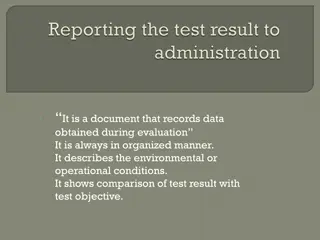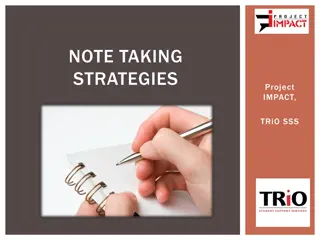Effective Test Taking Strategies for Success
Helpful tips for test takers include getting enough rest, following directions carefully, managing time wisely, and pacing yourself during exams. These strategies can boost your performance and lead to better outcomes on tests. Remember to prioritize your well-being and preparation to excel in your exams.
Download Presentation

Please find below an Image/Link to download the presentation.
The content on the website is provided AS IS for your information and personal use only. It may not be sold, licensed, or shared on other websites without obtaining consent from the author. Download presentation by click this link. If you encounter any issues during the download, it is possible that the publisher has removed the file from their server.
E N D
Presentation Transcript
15 Test Taking Strategies Every Test Taker Should Know
Test Taking Strategy # 1 Get plenty of rest the night before each testing day You need 8-10 hours of sleep, so go to bed by 10pm. Get ready before testing Eat a good nutritious breakfast the morning of each testing day (Milk w/cereal, eggs, fruits; no Hot Cheetos and candy.) Avoid the morning rush. Set out clothes the night before. Get to school a few minutes earlier than you usually do.
Can You Follow Directions? Get Out a Sheet of Paper and Take This Test. CAN YOU FOLLOW DIRECTIONS? This is a timed test--you have 3 minutes only! 1. Read everything carefully before doing anything. 2. Put your name in the upper right-hand corner of this paper. 3. Loudly call out your first name. 4. Circle your name. 5. If you have followed directions carefully to this point, call out "I have. 6. Draw five small squares in the upper left-hand corner. 7. Put an "X" in each square. 8. In your normal speaking voice, count from ten to one backwards. 9. Now that you have finished reading everything carefully, do only sentences one and two.
Test Taking Strategy # 2 Always listen to the directions given by teacher. Read the directions written on the test. Read the question and ALL answer choices before marking anything. LISTEN READ ASK Follow Directions!
Test Taking Strategy # 3 Use your time wisely! 2. It is important to answer every question even if you are not sure of the answer. 1. Don t spend too much time on any one question. 5. Answer the easiest questions first, but be sure to go back to those questions you skipped. 4. Save time at the end to review your test and make sure you haven't left out any answers. 3. Use all your time! There are no extra points for finishing early.
PACE YOURSELF ACT Aspire 7thand 8thReading- 31 Questions; 60 Minutes = An Average of Less Than 2 Minutes A Question ACT Aspire 7thMath- 41 Questions; 60 Minutes= An Average of About 1 Minute and 46 Seconds Per Question ACT Aspire 8thMath- 45 Questions; 65 Minutes= An Average of About 1 Minute and 44 Seconds Per Question REMEMBER TO DO THE EASIEST PROBLEMS FIRST AND THEN BE SURE AND GO BACK!
If you cant figure out which answer is correct, try to eliminate (get rid of) the answers that you know are wrong. Test Taking Strategy # 4 Eliminate obviously wrong answer choices Eliminate choices that are partly correct Eliminate items that are correct but don t answer the question Elimination
Test Taking Strategy # 5 Educated guessing means using everything you know to attempt to answer the question. A random guess gives you a 25% chance of getting the right answer. An educated guess gives you chance of answering correctly up to 75% . Educated Guess
Test Taking Strategy # 6 ANSWERS WITH THE FOLLOWING WORDS ARE USUALLY WRONG/FALSE. ALL MUST NONE NEVER EVERY ENTIRELY BEST WORST EVERYONE ALWAYS ONLY ABSOLUTE WORDS
ANSWERS WITH THE FOLLOWING WORDS ARE USUALLY CORRECT/TRUE Test Taking Strategy # 7 SOME SOMETIMES GENERALLY USUALLY FREQUENTLY PROBABLY MOST FEW MANY OFTEN SELDOM GENERAL WORDS
Test Taking Strategy # 8 The context of a word includes all the words and sentences that surround it and the situation in which the word is used. WHEN THE ANSWER IS NOT CLEAR, LOOK FOR CLUES ( CONTEXT, TENSE, WORD TYPE, GRAMMAR) IN THE QUESTION AND THE ANSWER CHOICES LOOK FOR CLUES
Test Taking Strategy # 8 continue... Clue words in test questions: Who?Person What? Thing Where? Place When?Time Why? Reason Which? Choice How?A way something is done How many ? Number LOOK FOR CLUES
Example Our class will see a play,__________ends this week. a.Who b.What c.Which d.When 1.Use elimination strategy first 2. Look for a clue 3. Play is a noun in this sentence, so ask yourself what kind of a play it is.
Test Taking Strategy # 9 The effect of negatives is to make the sentence the opposite of what it would be without the negative. Simplify the question by getting rid of double negatives. Negatives: Not None No one Hardly Scarcely Prefixes such as Un- Non- Dis- In- Simplify this statement: Most people are not unafraid of snakes. Most people are afraid of snakes. NEGATIVES & DOUBLE NEGATIVES
Example Mrs. Smith dislikes when students are being rude to their teachers. Without changing the meaning of the sentence, which words can best be used to replace the underlined part? A.Enjoys B.Tolerates C.Punishes D.Does not like
Test Taking Strategy # 10 In Math, ESTIMATING is an approximate answer obtained by rounding the numbers BEFORE you add, subtract, multiply, or divide. Always ask yourself: Is the answer reasonable? For example: For example: What is 325+917+ 796? A. 56 B. 2038 C. 1038 D. 10,564 Estimate
Examples What value of N makes the equation true? N-19=33 A. 245 B. 42 C. 14 D. 52 Eliminate obviously wrong answers first and then estimate!
Example An airplane flew 2905 miles in 5 hours. What was the speed of the plane? A. 12 miles per hour B. 2324 miles per hour C. 581 miles per hour D. 481 miles per hour
Test Taking Strategy # 11 1. 2. Check the units of measurement 3. Look for a pattern, trend, or comparison in the graph or table Read all the titles, labels, and other given information Questions with graphs, charts, and tables,
Test Taking Strategy # 12 1. Read the title of the map 2. Check the map key( legend) 3. Look at the map scale (if you need to find a distance) 4. Re-read the question again Questions with maps
Other Math Tips Use Scratch Paper. Double Check To Make Sure You've copied the problem correctly. Line Up Place Values (thousands, hundreds, tens, ones) Neatly To Avoid Careless Mistakes. Pace Yourself. MOVE ON AND GO BACK!
Test Taking Strategy # 13 Answers about where and when the story takes place are found at the beginning. Answers about a problem of the story are usually found in the middle. Answers about how the problem was resolved are usually found at the end. Reading a story
When Reading a Passage Remember To: READ THE QUESTIONS FIRST to determine what you are looking for as you read the selection.
Test Taking Strategy # 14 Events and characters that make up the story The purpose of the story The point the author is trying to make What s the Big Idea? Tip: Look for the Big idea in the first two paragraphs of the story! Finding the BIG IDEA
Example Read this outline of the article. I. Introduction II. Athenian Democracy III.Representative Democracy IV.Conclusion Which main idea belongs first under section III? a. Every citizen is a member of a government b. A presidential election is like a town meeting c. Al Gore got about 500,000 more votes than George Bush did d. A few elected officials represent a very large population Use all the strategies you have learned
KNOW THE MEANING OF THESE 12 POWER WORDS *Trace-outline, list in steps, or follow the path *Analyze-break into parts, tell about the parts *Infer-read between the lines, what is the hidden meaning *Evaluate-judge it, tell the good and the bad
KNOW THE MEANING OF THESE 12 POWER WORDS Continued *Formulate-create, put together *Describe-tell about, paint a picture with words *Support-back it up or prove it with details *Explain-teach me or show me the steps
KNOW THE MEANING OF THESE 12 POWER WORDS Continued *Summarize-tell the main idea, tell the beginning, middle, and end *Compare-tell the all the ways they are the same *Contrast-tell all the ways that they are different *Predict-What will happen next?
Test Taking Strategy # 15 Don t misbubble If you reach a hard question and can t make your educated guess, an easier one is just around the corner. Write a light ? next to the question you are skipping and move on to the next question.
How Do You Prevent Misbubbling? At the end of the test, go back to the questions with ? next to them and see if you can try to answer it. Please be sure to answer every question.
Final Tip Reminders If the test requires you to read passages and then answer questions about what you read, Read the questions first. Line up place value correctly on your scratch paper (thousands, hundreds, tens, ones). Remember: Never leave any question on a test blank.
When You Are Done Fill in bubbles fully, write neatly, and erase stray marks. If you finish early, check to make sure you have answered all questions. Once you have finished, please remain quiet as others will still be working on the test.
Remember I am scared of the test monster!!!! Remember the strategies! They will help you to feel confident. Think positively about doing your best! Take a deep breath to relax. Answer EVERY question. Make intelligent educated guesses. Think about one item at a time. DO YOUR BEST! Follow these tips to reduce your anxiety!
Reduce Your Test Anxiety With Practice Confidence comes from practice and becoming familiar with the format. USATestprep will give you the practice you need to help you stay calm and do your best.
By Using The Test Taking Strategies You Have Learned Today, and With Practice, You Can Improve Your Test Taking Skills and Test Scores. YOU CAN DO THIS! Sources: Preparing Middle School Students for High Stakes Tests, Tara Musslewhite, Atascocita Middle School, Humble, Texas 15 Strategies Every Test Taker Should Have, Vista Middle School, Van Nuys, CA























